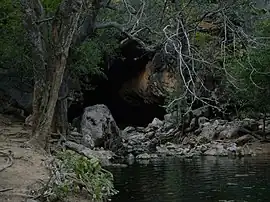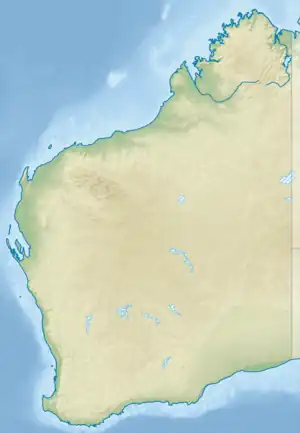| Tunnel Creek National Park Western Australia | |
|---|---|
 Tunnel Creek in the Kimberley region of Western Australia | |
 Tunnel Creek National Park | |
| Nearest town or city | Derby |
| Coordinates | 17°36′43″S 125°08′34″E / 17.61194°S 125.14278°E |
| Established | 1992 |
| Area | 91 ha (225 acres)[1] |
| Managing authorities | Department of Environment and Conservation |
| Website | Tunnel Creek National Park |
| See also | List of protected areas of Western Australia |
Tunnel Creek National Park is a national park in the Kimberley region of Western Australia, 1,845 kilometres (1,146 mi) northeast of Perth and 390 km (240 mi) east of Broome. The natural cave through which Tunnel Creek flows is a major attraction of the park.
Many Aboriginal rock paintings and speleothems are present in the cave decorating the walls. The cave was the hideout of the Aboriginal warrior, Jandamarra who was killed outside the entrance of the cave in 1897.[2] It is part of the Balili (Devonian Reef) Conservation Park.
Geography
The park is located in the Napier Range and covers an area of 91 hectares (220 acres). The range is composed of limestone and is the remains of a Devonian reef system formed around 350 million years ago.[3]
The tunnel component of Tunnel Creek has a length of approximately 750 m (2,460 ft) that runs underground and it one of the oldest cave systems in Western Australia.[4] The reef was first exposed around 250 million years ago and the first cave systems began to form, the present cave systems were created about 20 million years ago.
The cave reaches a maximum height of 12 m (39 ft) and has a maximum width of 15 m (49 ft). The creek was once known as "The Cave of the Bats" with at least five species of bat inhabiting the cavern. There are large pools of water on the floor of the cave in which freshwater crocodiles have been found. The pools indicate that the water table is only just below the present floor surface and water only flows through the area after heavy rainfall.[5]
References
- ↑ "Department of Environment and Conservation 2009–2010 Annual Report". Annual Report. Department of Environment and Conservation: 48. 2010. ISSN 1835-114X. Archived from the original on 11 January 2011.
- ↑ "Caves of Australia - Tunnel Creek National Park - Cave of Bats". 2009. Retrieved 19 February 2009.
- ↑ "Department of Environment and Conservation - Parkfinder - Tunnel Creek National Park". 2009. Retrieved 26 September 2010.
- ↑ "Kimberley Australia - Tunnel Creek National Park". 2009. Retrieved 19 February 2009.
- ↑ "Australian Good Food and Travel Guide - Tunnel Creek National Park". 2009. Retrieved 19 February 2009.